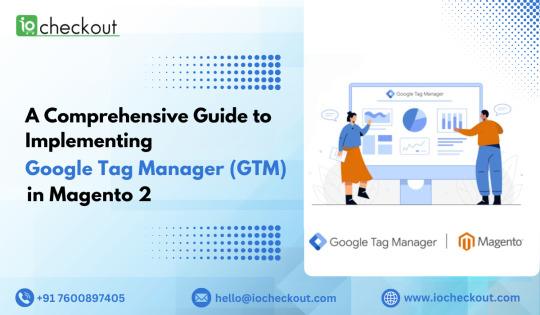#Magento Solution for eCommerce
Explore tagged Tumblr posts
Text
What Key challenges do you face in your retail business?
+ Reduction of operative cost and expenses
+ Seamless Customer Experience across all Channels
+ Right Technology Implementation
+ Increase of Customer base and Consumer engagement
+ Market business and create brand awareness
+ Automate process and technology
Connect us to help you in your retail business.

#technology#automation#startup#trendingnow#retailsolutions#retail technology#retail investors#techjour#retail#ecommerce#odoo crm#odoo services#odoo development company#odooimplementation#cloud solutions#cloud service provider#magento#customer experience#customer engagement
0 notes
Text
Discover the ultimate guide for a smooth transition from Magento to Shopify in 2025! This comprehensive resource offers step-by-step instructions, expert tips, and best practices to ensure your migration is hassle-free. Whether you're a seasoned e-commerce professional or a newcomer, you'll find valuable insights to help you retain your data, optimize your store's performance, and enhance customer experience. Source : https://www.krishangtechnolab.com/magento-to-shopify-migration/
#magento#shopify#ecommerce#ecommerce migration#Magento to Shopify#Magento to Shopify Migration#Magento to Shopify Migration 2025#ecommerce solutions#ecommerce migration expert#store migration
0 notes
Text
How to Choose the Best eCommerce Platform for Your Business: Shopify vs. WooCommerce vs. Magento

Confused about which eCommerce platform is right for your business? Check out our latest blog: "How to Choose the Best eCommerce Platform for Your Business: Shopify vs. WooCommerce vs. Magento!"
We break down the key features, benefits, and considerations for each platform, helping you make an informed decision that aligns with your goals. Whether you’re just starting or looking to scale, we’ve got you covered! 🚀
Don't miss out on essential insights that can shape your online success.
#ecommerce development company#ecommerce website development#ecommerce solutions#ecommerce#branding#startup#sales#entrepreneur#business growth#shopify#woocommerce#magento
0 notes
Text
#magento ecommerce development#oscommerce development#e-commerce solution provider from the netherland#best website design firm
0 notes
Text

Ready to invest in your business's future? 🚀 Amron Software is here to help! 💪 Our digital marketing experts will create a custom strategy just for you. 🎯 From SEO to social media, we've got you covered. 💥 Let's chat and see how we can help your business grow online. 📈 #digitalmarketing #onlinefuture #businessgrowth
#Online Business#Offline Business#Online Business vs Offline Business#Web Development Services#E-commerce Development#SEO Services#Magento Development#Flutter App Development#WordPress Development#online business#offline business#business models comparison#web development services#ecommerce solutions#SEO services
0 notes
Text
A Comprehensive Guide to Implementing Google Tag Manager (GTM) in Magento 2

Marketing is entirely contingent upon knowing the user's patterns of behavior. Using Google Tag Manager (GTM), industries can effectively measure marketing trends, gather informative data, and monitor user actions. GTM and Magento 2 integration will enhance your data collection skills even more, helping you make the proper decision. This how-to manual graciously introduces the GTM system in Magento 2, emphasizing IoCheckout as a specific example and explaining the benefits and easy installation differentiator.
Understanding Google Tag Manager (GTM)
Google Tag Manager is a free tool for managing and deploying marketing tags (code snippets or tracking pixels) on your website without cheating the source code. GTM makes it simpler to attach new tags, which in turn enables you to follow up on user interactions, conversion rates, and other main factors.
Benefits of GTM Tracking
Ease of Setup and Use: GTM's interface is friendly and intuitive, just like you would expect it to be, even if you are not a computer professional.
Centralized Management: All your tags are stored in one place, which helps prevent mistakes and simplifies the whole process.
Customization and Flexibility: GTM allows for incredible custom changes, which let you monitor almost any user interaction and behavior you like.
Enhanced Marketing Insights: By analyzing user movements, GTM gives you real-time data crucial for refining marketing campaigns and increasing overall performance.
Integrating GTM with Magento 2
Integrating GTM into Magento 2 encompasses some cardinal steps, briefly run below. Also, the IoCheckout extension can be used in this situation; it will be easier this way, and the store admins will already have the checkout tracking set up as a default, which will take care of the user experience for the customer who is shopping on the site.
Step 1: Create an Account and Integrate IoCheckout
Sign Up for GTM: If you do not have a GTM account, you can get one by signing up at tagmanager.google.com.
Create a Container: After the sign-in step, reserve a new container to manage all your tags, triggers, and variables for your Magento 2 store.
Step 2: Add the GTM Code to Magento 2
Obtain the GTM Code: When you create the container, GTM will give you the HTML code and a second snippet.
Insert Code into Magento 2: Enter the following code into your Magento 2 store. Ideally, utilize the code in multiple web page regions, such as the header and body sections.
Step 3: Configure GTM Tags, Triggers, and Variables
Get Tags Ready: Tags are short pieces of code that you can insert into your website to track user actions. Well-known tags are Google Analytics, AdWords, and remarketing tags.
Setting Triggers: Triggers are the ones you can use to get your tags fired on any page you want. For example, to include or exclude a single or multiple pages on a website, click a form, or click an element.
Variable Creation: The variables replace the values that GTM uses to produce the tags and triggers. Surprisingly, this includes the contact form ID, website click text, and page URI.
Enhancing GTM with IoCheckout for Magento 2
IoCheckout is a Magento 2 extension that simplifies the checkout process and includes GTM tracking features. Customers can practically discern the advantages and disadvantages of these online stores by providing a glimpse into the network of grocery chain retailers.
Key Features of IoCheckout
Pre-configured GTM Tracking: The Magento 2 IoCheckout module comes with pre-configured GTM tracking for each step of the checkout process. It, therefore, facilitates the development of one to several technology concepts, including IoT and human-machine interaction, growth and management of local data, introducing analytics, network security, software development, and many other similar disciplines. Users can select and start navigating to their chosen day and time. This helps the customer to know the start time while watching for the train arrival timeframe.
Customization Options: Customizing the tracking code would be very useful. For example, it can be the addition of a required personal data field for a smoother registration process or the live address validation that saves customers time by ensuring they use the correct address the first time. These are steps where IoT technology can assist in dealing with actual problems.
Comprehensive Data Collection: IoCheckout, which you might have heard of and will tell you more about, is a powerful tool for upgrading the checkout process of your e-commerce store. Having given you all these examples, we want you to appreciate the IoT power and the hurdles the industry might face in the years ahead.
Examples include the possibility of unlocking doors through your voice, whether this will replace traditional security quickly or not. Research has been carried out on various IoT technology applications already on the market, and some are still under development. To replicate it, almost the same data should be available.
Measuring Checkout Steps with IoCheckout
Users will talk about their experience in the grocery retail environment, followed by solutions and innovation with new technologies. The checkout process is the most crucial stage in a customer's journey. You can only hop on with the task after first intelligently personalizing the network service for the customer so that you don't end up providing the wrong item, equivalently failing and potentially losing customer trust. IoCheckout's GTM tracking features make it possible for you to:
Track Each Step of the Checkout: Monitor user progress through each checkout process step, from cart review to payment confirmation. To deliver the broad range that customers have come to expect, networks must figure out how to achieve long-term success in terms of their connections' number, variety, and speed. One of the benefits of IoT for the development of smart cities is that it could help.
Optimize User Experience: By utilizing GTM tracking observations, you can customize the checkout process and improve the consumer's experience.
Essence
Google Tag Manager integration into Magento 2 is the best way to improve your different angles of tracking and marketing. GTM allows you to set short descriptions that can be managed and deployed through tags. Additionally, you can do configuration tracking according to your specific needs, and as a result, you will have access to the user behavior data. Implementing the IoCheckout extension can further optimize the process, as it was designed to include the GTM pre-configured tag system for checkout and comprises the option of extra customization. Through GTM and IoCheckout integration with your Magento 2 store, you can reach the full potential of your marketing efforts, make your website more user-friendly, and convert more customers.
#magento 2 google tag manager#Magento 2 GTM Tracking#GTM Tracking#magento 2 gtm#magento google tag manager#magento 2 tag manager#Google Tag Manager#Magento 2#eCommerce Solutions#google tag manager magento 2#magento 2 google tag manager extension
0 notes
Text

Sigma Solve adopted a stand-alone approach in developing an eCommerce web solution that showcase all major products for sub-dealers across the region. For Sigma Solve, leveraged Magento 2 for developing headless architecture to help Modern Electronics manage their product listing and various loyalty and finance programs. Sigma Solve utilized node.js and react.js to build a user-friendly and responsive frontend of the eCommerce platform.
0 notes
Text
Essential Steps for Testing and Validating Your Magento Upgrade

Upgrading your Magento requires smart planning, precise execution, and thorough testing. To stay on top in the online selling game, it’s crucial to make the most of the newest technologies, patches, and performance enhancements. A smooth transition is key, and that means relying on expert know-how and following the best methods. Opt for our Magento upgrade services to effortlessly enhance and revamp your online store.
Executing a prosperous Magento upgrade demands proficiency in various domains. For peak performance, meticulous planning and rigorous testing are essential at every stage. Navigating this journey calls for expert assistance, guaranteeing seamless transitions while safeguarding crucial features and user experiences.
A knowledgeable guide that delves into the details of testing and validating your Magento upgrade. Planning, testing, security, optimizing performance, and ongoing monitoring are crucial elements to ensure a seamless Magento upgrade while preserving operational integrity.
Important Key features of Magento 2.
Enhancements in scalability and performance.
Magento 2 platform is crafted to deliver improved performance and scalability. Utilizing full-page caching, refined indexing, and optimized coding has notably boosted the website’s speed and overall performance. Catering to the expanding requirements of businesses, the platform’s scalability enables it to manage larger product catalogs and increased website traffic.
Streamlined Checkout Process
The Magento 2 platform is created to offer improved performance and scalability. Through the implementation of full-page caching, enhanced indexing, and optimized coding, the website’s speed and overall performance have seen a substantial increase. To meet the expanding demands of businesses, the platform’s scalability enables it to efficiently manage larger product catalogs and handle increased traffic.
Design and Optimization for Mobile-Friendly Experience
Magento 2 prioritizes mobile optimization and responsive design, recognizing the significance of mobile devices. A responsive design and interface guarantee a captivating and smooth shopping experience across all devices. The mobile responsiveness of the site plays a role in boosting user engagement and driving sales.
User-Friendly Admin Panel
Magento 2 incorporates an improved admin panel, designed for enhanced user-friendliness and efficiency. With a more intuitive user interface, improved navigation, and enhanced usability, merchants can seamlessly manage products, create content, and process orders. This user-friendly admin panel simplifies various tasks for merchants.
Handling Advanced Products
Magento 2 enables merchants to efficiently manage their products. Through features like drag-and-drop product creation, batch updates, and customizable attributes, store administrators can save time and effort.
Key Tips for Successfully Testing Your Magento Upgrade
Establish a Strong Base through Planning and Preparation
The initial phase of a Magento upgrade involves meticulous planning and thorough preparation. Develop a comprehensive roadmap outlining each step of the upgrade process. This plan should encompass risk assessments, contingency strategies, and a thorough backup strategy. Ensure that extensions, themes, and customizations are fully compatible with the new version. Implementing a robust backup strategy is crucial to prevent potential issues during the upgrade process.
Conducting Methodical Testing while Upholding Integrity and Functionality
Performing testing in a staging environment, mirroring the live production setting, is crucial. This enables thorough testing without jeopardizing the functionality of the live site. Evaluate every facet of the upgraded platform, encompassing core functionality, additional programming, extensions, and integrations. Identifying potential issues before deploying the live upgrade is imperative.
Ensuring Functionality and Regression Testing
Prioritize Functional Testing to guarantee flawless operation of essential features post-upgrade. Confirm smooth functionality of user accounts and checkout processes. Additionally, Regression Testing is vital to ensure existing features remain unaffected and perform optimally after an upgrade. The goal of this step is to identify and resolve any unexpected issues that may arise.
Verification of Extension and Theme Compatibility
Ensure compatibility of all extensions and themes with the upgraded Magento version. The extension/theme developer should furnish the latest versions or patches to facilitate seamless integration. Explore alternative extensions/themes or customize them to align perfectly with the upgraded version of Magento, resolving any compatibility issues.
Enhancing Performance for Improved User Experience
In the performance testing phase, assess the Magento platform for responsiveness, speed, and overall performance. Utilize performance testing tools to simulate various user scenarios and evaluate how well the platform manages different loads. Identify any performance bottlenecks and address them to optimize the platform’s speed.
More Info: https://www.evrig.com/blog/essential-steps-for-testing-and-validating-magento-upgrade/
0 notes
Text
Magento Open Source vs. Adobe Commerce: How to Choose
This article outlines distinctions between the 2 platforms and offers customized insights for businesses seeking Magento e-commerce solutions USA.
0 notes
Text
Magento 2 Development Guide: Tips for eCommerce Success

Dive into the dynamic world of Magento 2 with this engaging guide! It unveils the secrets to leveraging Magento 2 for creating standout eCommerce stores. From enhancing performance to ensuring top-notch security, the blog explores how this platform is a game-changer for businesses of all sizes. Perfect for those eager to elevate their online retail presence.
Uncover more captivating insights by reading the full blog here.
#magento 2#Magento 2 Development#eCommerce Solutions#web application development#magento 2 extension#Magento 2 Guide
1 note
·
View note
Text

#magento#Magento Custom Development Services in Dubai#Magento Installation Service Dubai#Magento Configuration Service Dubai#Magento Integration Services Dubai#Magento SEO Services Dubai#Magento Design and Development Services Sharjah#Magento Development near Sharjah#Magento website development in dubai#Magento development dubai#Magento ecommerce development dubai#Magento Mobile App Development Dubai#Magento 1 to 2 Migration Services Dubai#Magento web development in dubai#Magento development company in uae#Magento Omni Channel Solutions Dubai#Magento website development services Sharjah
0 notes
Text
#oscommerce development#magento ecommerce development#shopify developer#e-commerce solution provider from the netherland
0 notes
Text
Are You Looking For Magento Ecommerce Development ? Don’t wait just connect with Futuresoftindia.
If it comes to Magento web development, I would like to recommend Leading company Futuresoftindia for its best services in Software Development & Solutions. FutureSoft is a Magento Solution Company with deep skills in providing Magento development Services for your robust eCommerce portal.

would you like to work with Futuresoftindia. link is given below, click and connect with top magento development company of india.
Futuresoftindia.com- Leading Magento Development Company
We Provide Complete Solution for eCommerce
A Magento Solution Company with extensive Magento Development Services expertise for your powerful eCommerce portal. We meet your needs by creating a custom solution using Magento Services & Magento Integration in accordance with your requirements.
#Magento development company#magento development services#magento headless#magento solutions#magento services#ecommerce using magento#ecommerce
1 note
·
View note
Text
Enhance Your Magento 2 Store with GTM and IoCheckout
Explore the world of Google Tag Manager (GTM) and Magento 2 integration using IoCheckout. This comprehensive guide explains how to configure GTM, create tags, triggers, and variables, and use IoCheckout for a more efficient checkout process. With this powerful combination, you can gain valuable marketing insights while improving the user experience.
#magento 2 google tag manager#Magento 2 GTM Tracking#GTM Tracking#magento 2 gtm#magento google tag manager#magento 2 tag manager#Google Tag Manager#Magento 2#eCommerce Solutions#google tag manager magento 2#magento 2 google tag manager extension
0 notes
Text
0 notes
Text
Sigma Solve offer tailor made magento development services to deliver client-centered eCommerce solutions that helps to grow your online business. Our team of skilled developers excels in harnessing the power of Magento to deliver exceptional results. We provide highly functional and visually stunning ecommerce websites development ensuring that it is custom-tailored to meet our clients’ specific business requirements.
#ecommerce development services#ecommerce solutions#magento website development#magento developers#magento development company
0 notes